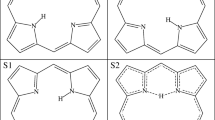Abstract.
The valence π → π * excited states of anthracene and naphthacene are studied with multireference perturbation theory with complete active space self-consistent field reference functions. The predicted spectra provide a consistent assignment of all one- and two-photon spectra and T-T spectra of low-lying valence π → π * excited states of anthracene and naphthacene. The present theory predicts the valence π → π * excitation energies with an accuracy of 0.15 eV for anthracene and of 0.25 eV or better for naphthacene. The excited states of anthracene and naphthacene are compared with those of benzene and naphthalene studied previously. The present calculations predict that, going from anthracene to naphthacene, there is a symmetry reversal of the two lowest singlet state transitions, but not for the triplet, just as indicated by the experimental data. Some general trends of polyacene excited states are discussed based on the calculated results for benzene to naphthacene. Conclusive results obtained for anthracene and naphthacene can be used as a model for understanding the excited states of larger polyacenes.
Similar content being viewed by others
Author information
Authors and Affiliations
Additional information
Received: 22 April 1998 / Accepted: 6 July 1998 / Published online: 28 September 1998
Rights and permissions
About this article
Cite this article
Kawashima, Y., Hashimoto, T., Nakano, H. et al. Theoretical study of the valence π → π* excited states of polyacenes: anthracene and naphthacene. Theor Chem Acc 102, 49–64 (1999). https://doi.org/10.1007/s002140050472
Issue Date:
DOI: https://doi.org/10.1007/s002140050472




